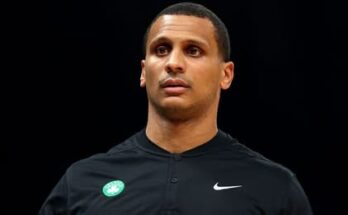Jonathan Kuminga’s Preferred Trade Destination Surfaces Amid Contract Negotiation Deadlock with Warriors
The ongoing contract stalemate between Jonathan Kuminga and the Golden State Warriors has taken a new turn, as reports emerge revealing the young forward’s preferred trade destination amid mounting frustration with the negotiations. This development adds a fresh layer of complexity to an already tense offseason saga, bringing into focus the challenges faced by both Kuminga and the Warriors as they try to navigate the future of this promising player.
Jonathan Kuminga, once heralded as a key piece of the Warriors’ rebuilding process, has found himself at the center of an impasse that threatens to disrupt his trajectory with the team. Since entering the league, Kuminga’s blend of athleticism, defensive versatility, and raw potential positioned him as a cornerstone for Golden State’s next chapter. However, as contract talks have dragged on without resolution, reports now suggest that Kuminga is actively seeking a change of scenery and has expressed a preference for being traded to a particular team.
The Warriors’ front office has been engaged in what many characterize as a difficult negotiation with Kuminga’s representatives. The sticking points reportedly involve the length and financial terms of the contract, with the Warriors hesitant to meet the high demands amid salary cap constraints and luxury tax considerations. Kuminga, on the other hand, is pushing for a deal that better reflects his value and potential role within the league, leading to a standoff that shows no immediate signs of breaking.
It is in this context that Kuminga’s preferred trade destination has come to light, providing insight into where the young forward sees the best opportunity for growth, playing time, and career advancement. While the specific team has not been officially confirmed by all parties, multiple reliable sources have indicated a strong mutual interest between Kuminga and a franchise known for its commitment to developing young talent and providing ample opportunity for emerging players to flourish.
This preference is more than just a mere rumor—it signals Kuminga’s intent to take control of his career path amid uncertainty with the Warriors. For a player still in the early stages of his professional journey, finding a team where he can secure a defined role and consistent minutes is critical. The desire for a fresh start often stems from a belief that new environments can better harness a player’s strengths and accelerate their development.
From Golden State’s perspective, this revelation adds pressure to an already delicate situation. The franchise faces a tough decision: either escalate their contract offer to meet Kuminga’s expectations and secure his future with the team or explore trade possibilities that could bring back valuable assets while allowing both sides to move forward. The choice is complicated by the fact that Kuminga represents an important piece of the Warriors’ long-term plan, blending youth with the veteran core that has sustained the team’s recent success.
This emerging trade preference also highlights a broader theme within the NBA, where players increasingly assert agency in shaping their careers. Young stars like Kuminga are no longer passive recipients of team decisions; they actively voice preferences and seek environments conducive to their personal and professional growth. This shift challenges franchises to not only manage talent but also to engage in open dialogue and flexible negotiation strategies.
The potential trade destination identified aligns with a team undergoing a transformation—one focused on youth development, fostering a strong locker room culture, and competing with an eye toward future success. For Kuminga, joining such a team could mean increased playing time, a clearer role in the offense and defense, and a coaching staff dedicated to maximizing his skills. It presents an enticing alternative to the uncertainty that has marked his current situation in Golden State.
If a trade materializes, it will inevitably reshape the Warriors’ roster and strategy. Moving Kuminga could free up salary cap space, allowing Golden State to pursue other targets in free agency or trades. Conversely, it could also represent a loss of potential long-term value, forcing the team to accelerate the development of other young players or seek new talent through the draft.
For the player, this potential shift underscores the volatile nature of NBA careers. Even promising young talents must navigate the intricacies of contract negotiations, team dynamics, and personal aspirations. Kuminga’s willingness to request a trade speaks to his confidence in his abilities and his desire to find the best fit to maximize his impact on the court.
The Warriors’ fan base watches closely as this saga unfolds, aware that the outcome will influence not only the team’s competitive prospects but also the message it sends about the franchise’s commitment to nurturing homegrown talent. Golden State has long been praised for its player development programs, and how they handle Kuminga’s situation will be scrutinized as a measure of their continued effectiveness in that regard.
League analysts and insiders speculate that the resolution of this impasse could serve as a bellwether for how NBA teams approach contract negotiations and player retention in an era of increasing player empowerment. The balance between fiscal responsibility and investing in young talent is delicate, and Kuminga’s case exemplifies the complexities involved.
Ultimately, the next steps in Kuminga’s career hinge on whether the Warriors and the player can bridge the gap in their contract expectations or if a trade will provide the fresh start that Kuminga evidently seeks. Either path carries risks and opportunities, with long-term ramifications for both the player and the franchise.
As the offseason progresses, the situation demands careful navigation. For Kuminga, securing a situation that allows him to flourish is paramount. For Golden State, maintaining a competitive roster while managing financial realities is equally critical. The intersection of these priorities will define the next chapter in this evolving story.
In summary, Jonathan Kuminga’s preferred trade destination emerging amid contract stalemate signals a pivotal moment in his career and the Warriors’ strategic planning. It highlights the complexities of player-team relationships in today’s NBA and the increasing influence players wield in directing their professional futures. How this saga resolves will not only impact Kuminga and the Warriors but also offer insights into the broader landscape of talent management in professional basketball. Fans, teams, and analysts alike await the outcome, understanding that this story represents more than just one player’s contract—it reflects the evolving nature of the league itself.



